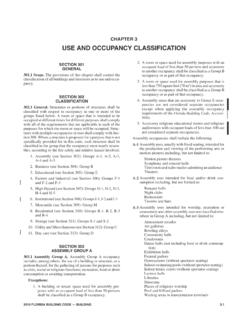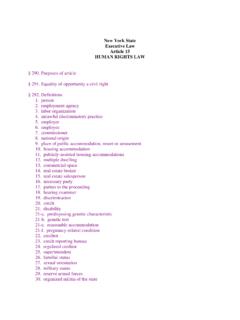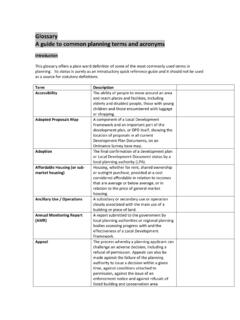Transcription of Protecting Yourself When Handling Contaminated Sharps
1 FactSheet Protecting Yourself when Handling Contaminated Sharps Sharps are objects that can penetrate a worker's skin, such as needles, scalpels, broken glass, capillary tubes and the exposed ends of dental wires. If blood or other potentially infectious materials (OPIM), as defined in the OSHA Bloodborne Pathogens standard (29 CFR ), are present or may be present on the sharp , it is a Contaminated sharp and appropriate personal protective equipment must be worn. A needlestick or a cut from a Contaminated In some cases, they may be placed on carts to sharp can result in a worker being infected with prevent patients, such as psychiatric patients or human immunodeficiency virus (HIV), hepatitis children, from accessing the Sharps . Containers B virus (HBV), hepatitis C virus (HCV), and other also must be available wherever Sharps may be bloodborne pathogens. The standard specifies found, such as in laundries . measures to reduce these types of injuries and Contaminated Sharps must never be sheared the risk of infection.
2 Or broken. Recapping, bending, or removing Careful Handling of Contaminated Sharps can needles is permissible only if there is no feasible prevent injury and reduce the risk of infection. alternative or if such actions are required Employers must ensure that workers follow for a specific medical or dental procedure. If these work practices to decrease the workers' recapping, bending, or removal is necessary, chances of contracting bloodborne diseases. employers must ensure that workers use either a mechanical device or a one-handed technique. Safer Medical Devices The cap must not be held in one hand while Employers are required to consider and use guiding the sharp into it or placing it over the safer medical devices, wherever possible. These sharp . A one-handed scoop technique uses devices include those that are needleless or the needle itself to pick up the cap, and then the have built-in protection to guard workers against cap is pushed against a hard surface to ensure contact with the Contaminated sharp .
3 In addition, a tight fit onto the device. Also, the cap may be employers must ask non-managerial patient care held with tongs or forceps and placed over the workers who could be exposed to Contaminated needle. Contaminated broken glass must not be Sharps injuries for their input in identifying, picked up by hand, but must be cleaned up using evaluating and selecting effective work practice mechanical means, such as a brush and dust and engineering controls, including safer pan, tongs, or forceps. medical devices. The employer must document consideration and implementation of these Sharps Containers devices, and the solicitation of worker input, in Containers for Contaminated Sharps must be the Exposure Control Plan. puncture-resistant. The sides and the bottom must be leakproof. They must be appropriately Prompt Disposal labeled or color-coded red to warn everyone Employers must also ensure that Contaminated that the contents are hazardous. Containers for Sharps are disposed of in Sharps disposal disposable Sharps must be closable (that is, have containers immediately or as soon as feasible a lid, flap, door, or other means of closing the after use.)
4 Sharps disposal containers must container), and they must be kept upright to keep be readily accessible and located as close as the Sharps and any liquids from spilling out of feasible to the area where Sharps will be used. the container. The containers must be replaced routinely and Receive information and training (in a not be overfilled, which can increase the risk of language and vocabulary the worker needlesticks or cuts. Sharps disposal containers understands) about workplace hazards, that are reusable must not be opened, emptied, methods to prevent them, and the OSHA. or cleaned manually or in any other manner standards that apply to their workplace. that would expose workers to the risk of Sharps Review records of work-related injuries injury. Employers also must ensure that reusable and illnesses. Sharps that are Contaminated are not stored or File a complaint asking OSHA to inspect processed in a manner that requires workers to their workplace if they believe there is a reach by hand into the containers where these serious hazard or that their employer is not Sharps have been placed.
5 Following OSHA's rules. OSHA will keep all identities confidential. Handling Containers Exercise their rights under the law without Before Sharps disposal containers are retaliation, including reporting an injury or removed or replaced, they must be closed raising health and safety concerns with their to prevent spilling the contents. If there is a employer or OSHA. If a worker has been chance of leakage from the disposal container, retaliated against for using their rights, they the employer must ensure that it is placed must file a complaint with OSHA as soon as in a secondary container that is closable, possible, but no later than 30 days. appropriately labeled or color-coded red, and constructed to contain all contents and For additional information, see OSHA's Workers prevent leakage during Handling , storage, page ( ). transport, or shipping. How to Contact OSHA. Additional Information Under the Occupational Safety and Health For more information, go to OSHA's Bloodborne Act of 1970, employers are responsible for Pathogens and Needlestick Prevention Safety providing safe and healthful workplaces and Health Topics webpage at: for their employees.
6 OSHA's role is to help bloodborne-pathogens. ensure these conditions for America's working men and women by setting and enforcing Workers' Rights standards, and providing training, education, Workers have the right to: and assistance. For more information, visit or call OSHA at 1-800-321-OSHA. Working conditions that do not pose a risk of (6742), TTY 1-877-889-5627. serious harm. This is one in a series of informational fact sheets highlighting OSHA programs, policies or standards. It does not impose any new compliance requirements. For a comprehensive list of compliance requirements of OSHA standards or regulations, refer to Title 29 of the Code of Federal Regulations. This information will be made available to sensory-impaired individuals upon request. The voice phone is (202) 693-1999; teletypewriter (TTY) number: (877) 889-5627. DSG FS-3519 01/2011.















